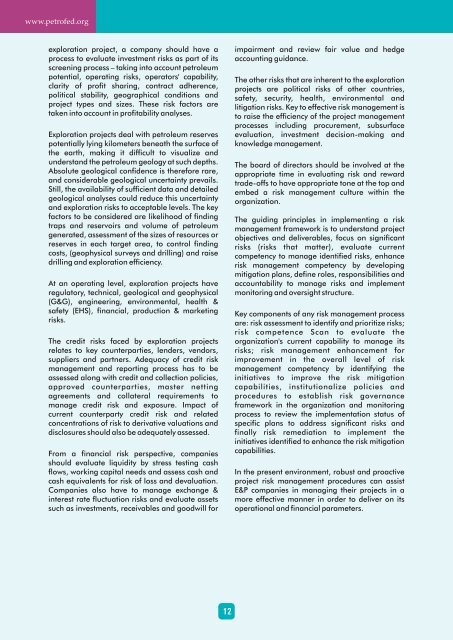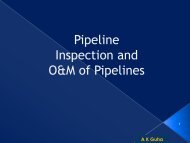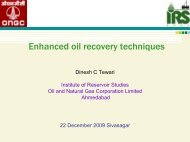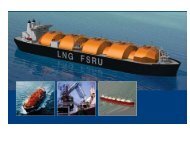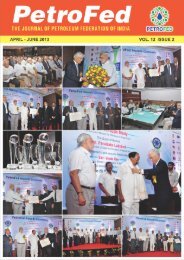Chapter -1 final last new font final - petrofed.winwinho...
Chapter -1 final last new font final - petrofed.winwinho...
Chapter -1 final last new font final - petrofed.winwinho...
You also want an ePaper? Increase the reach of your titles
YUMPU automatically turns print PDFs into web optimized ePapers that Google loves.
www.<strong>petrofed</strong>.org<br />
exploration project, a company should have a impairment and review fair value and hedge<br />
process to evaluate investment risks as part of its<br />
screening process – taking into account petroleum<br />
accounting guidance.<br />
potential, operating risks, operators' capability,<br />
clarity of profit sharing, contract adherence,<br />
political stability, geographical conditions and<br />
project types and sizes. These risk factors are<br />
The other risks that are inherent to the exploration<br />
projects are political risks of other countries,<br />
safety, security, health, environmental and<br />
taken into account in profitability analyses.<br />
12<br />
litigation risks. Key to effective risk management is<br />
to raise the efficiency of the project management<br />
processes including procurement, subsurface<br />
Exploration projects deal with petroleum reserves evaluation, investment decision-making and<br />
potentially lying kilometers beneath the surface of knowledge management.<br />
the earth, making it difficult to visualize and<br />
understand the petroleum geology at such depths.<br />
The board of directors should be involved at the<br />
Absolute geological confidence is therefore rare,<br />
appropriate time in evaluating risk and reward<br />
and considerable geological uncertainty prevails.<br />
trade-offs to have appropriate tone at the top and<br />
Still, the availability of sufficient data and detailed<br />
embed a risk management culture within the<br />
geological analyses could reduce this uncertainty<br />
organization.<br />
and exploration risks to acceptable levels. The key<br />
factors to be considered are likelihood of finding<br />
The guiding principles in implementing a risk<br />
traps and reservoirs and volume of petroleum<br />
management framework is to understand project<br />
generated, assessment of the sizes of resources or<br />
objectives and deliverables, focus on significant<br />
reserves in each target area, to control finding<br />
risks (risks that matter), evaluate current<br />
costs, (geophysical surveys and drilling) and raise<br />
drilling and exploration efficiency.<br />
competency to manage identified risks, enhance<br />
risk management competency by developing<br />
mitigation plans, define roles, responsibilities and<br />
At an operating level, exploration projects have accountability to manage risks and implement<br />
regulatory, technical, geological and geophysical monitoring and oversight structure.<br />
(G&G), engineering, environmental, health &<br />
safety (EHS), financial, production & marketing<br />
risks.<br />
Key components of any risk management process<br />
are: risk assessment to identify and prioritize risks;<br />
risk competence Scan to evaluate the<br />
The credit risks faced by exploration projects organization's current capability to manage its<br />
relates to key counterparties, lenders, vendors, risks; risk management enhancement for<br />
suppliers and partners. Adequacy of credit risk improvement in the overall level of risk<br />
management and reporting process has to be management competency by identifying the<br />
assessed along with credit and collection policies, initiatives to improve the risk mitigation<br />
approved counterparties, master netting capabilities, institutionalize policies and<br />
agreements and collateral requirements to procedures to establish risk governance<br />
manage credit risk and exposure. Impact of framework in the organization and monitoring<br />
current counterparty credit risk and related process to review the implementation status of<br />
concentrations of risk to derivative valuations and specific plans to address significant risks and<br />
disclosures should also be adequately assessed. <strong>final</strong>ly risk remediation to implement the<br />
initiatives identified to enhance the risk mitigation<br />
capabilities.<br />
From a financial risk perspective, companies<br />
should evaluate liquidity by stress testing cash<br />
flows, working capital needs and assess cash and In the present environment, robust and proactive<br />
cash equivalents for risk of loss and devaluation. project risk management procedures can assist<br />
Companies also have to manage exchange & E&P companies in managing their projects in a<br />
interest rate fluctuation risks and evaluate assets more effective manner in order to deliver on its<br />
such as investments, receivables and goodwill for operational and financial parameters.


